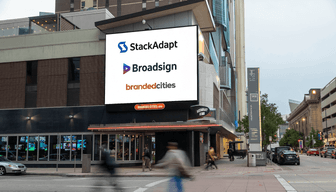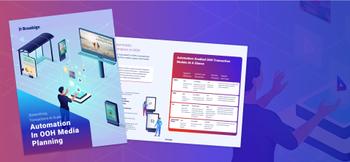New feature sets the stage for more automated, programmatic OOH creative approval workflows; accelerates campaign turnaround, enabling media owners to access untapped revenue
MONTREAL, Feb 5, 2025 – Live from its annual customer summit, Broadsign Connect, in Barcelona, Spain, Broadsign today unveiled a preview of an artificial intelligence (AI) powered creative categorization and approval feature coming to its out-of-home (OOH) advertising platform this spring.
A first-of-its-kind development for the OOH industry, the Broadsign AI Assistant is a patent-pending tool designed to substantially reduce the time media owners spend on repetitive tasks such as reviewing, categorizing, and approving incoming ad creative from programmatic bids sent via demand-side platforms (DSP). It promises significant time and cost savings for media owners, as tens of thousands of unique OOH creatives are reviewed and categorized manually per month, with 100 percent year-over-year growth anticipated.
As ad creatives are submitted to the Broadsign Supply-Side Platform (SSP), the Broadsign AI Assistant will email media owners with category and approval suggestions for each ad. These recommendations are based on detailed creative analysis and learnings from the media owner’s existing inventory taxonomy on the direct-sales side of their business to enable cross-channel competitive separation.
The technology scans the creative for inventory qualities like aspect ratio, resolution, profane language, and more, as well as objects that can provide insight into which category from the media owner’s taxonomy the creative best fits, like a car for an automotive category. Leveraging that analysis, the assistant then provides approval and categorization suggestions based on that data, which media owners can opt to approve, reject, or send to their team for closer review.
By automating the categorization process, the Broadsign AI Assistant can minimize common misclassification errors and quickly identify sensitive content that could hamper brand safety efforts, such as creative featuring alcohol for a screen near a school, or an ad that violates local laws, like a political ad for a display located next to a polling location.
Broadsign fine-tuned and trained the large language model (LLM) behind the Broadsign AI Assistant using two years of categorization data aggregated from DSP bids received by Broadsign customers. Once live and in use, it will continue to learn and improve its recommendations based on each media owner’s specific categorization and approval practices.
“Automating OOH workflows is pivotal to the medium’s continued growth, and OOH categorization and approval is a great starting point. Today, the manual process ties up hours of cycles evaluating creative that may not even win the bid,” explained Broadsign VP of Products, Francois Hechme. “The Broadsign AI Assistant can process and categorize vast volumes of creative simultaneously to help teams keep up with programmatic demand, so they can spend more time building and nurturing media buyer relationships and improving reporting. We’ve designed it so that media owners retain control over when and how they use it, so it complements, rather than detracts from their work.”
The Broadsign AI Assistant is expected to launch in early Q2 of 2025 and will be available to customers using the Broadsign SSP and Header Bidder. For more information on the Broadsign Platform, visit: https://broadsign.com/broadsign-platform/
About Broadsign
Broadsign empowers media owners, agencies, and brands to harness the power and reach of out-of-home to connect with audiences in ways unlike any other advertising channel. More than 1.5 million static and digital signs along roadways and in airports, shopping malls, retailers, health clinics, transit systems, electric vehicle charging stations, and more run on Broadsign, reaching audiences at multiple touchpoints throughout the consumer journey. The Broadsign Platform helps media owners such as Outfront, Pattison Outdoor, Global, and Intersection streamline business operations and maximize revenue opportunities while enabling marketers and agencies to more easily plan and execute dynamic OOH campaigns that resonate with audiences. Brands spanning AB InBev, Disney, FanDuel, H&M, Honda, HP, Johnson & Johnson, KLM, Uber Eats, Sea-Doo, Samsonite, and many more have run successful programmatic DOOH campaigns enabled by Broadsign technology. https://broadsign.com





